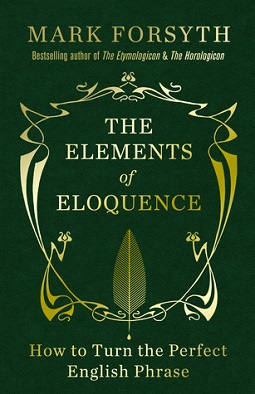
A figure of speech or rhetorical figure is a word or phrase that intentionally deviates from ordinary language use to produce a rhetorical effect. Figures of speech are traditionally classified into schemes, which vary the ordinary sequence of words, and tropes, where words carry a meaning other than what they ordinarily signify.
Antithesis is used in writing or speech either as a proposition that contrasts with or reverses some previously mentioned proposition, or when two opposites are introduced together for contrasting effect. This is based on the logical phrase or term.

In rhetoric, chiasmus or, less commonly, chiasm, is a "reversal of grammatical structures in successive phrases or clauses – but no repetition of words".
In rhetoric, litotes, also known classically as antenantiosis or moderatour, is a figure of speech and form of verbal irony in which understatement is used to emphasize a point by stating a negative to further affirm a positive, often incorporating double negatives for effect. Litotes is a form of understatement, which can be in the form of meiosis, and is always deliberate with the intention of emphasis. However, the interpretation of negation may depend on context, including cultural context. In speech, litotes may also depend on intonation and emphasis; for example, the phrase "not bad" can be intonated differently so as to mean either "mediocre" or "excellent". Along the same lines, litotes can be used, to euphemistically provide emphasis by diminishing the harshness of an observation; "He isn't the cleanest person I know" could be used as a means of indicating that someone is a messy person.
Hyperbole is the use of exaggeration as a rhetorical device or figure of speech. In rhetoric, it is also sometimes known as auxesis. In poetry and oratory, it emphasizes, evokes strong feelings, and creates strong impressions. As a figure of speech, it is usually not meant to be taken literally.

In rhetoric, a rhetorical device, persuasive device, or stylistic device is a technique that an author or speaker uses to convey to the listener or reader a meaning with the goal of persuading them towards considering a topic from a perspective, using language designed to encourage or provoke an emotional display of a given perspective or action. They seek to make a position or argument more compelling than it would otherwise be.
In rhetoric, zeugma and syllepsis are figures of speech in which a single phrase or word joins different parts of a sentence.
In literature and writing, stylistically elements are the use of any of a variety of techniques to give an auxiliary meaning, ideas, or feeling to the literalism or written.
A paraprosdokian is a figure of speech in which the latter part of a sentence, phrase, or larger discourse is surprising or unexpected in a way that causes the reader or listener to reframe or reinterpret the first part. It is frequently used for humorous or dramatic effect, sometimes producing an anticlimax. For this reason, it is extremely popular among comedians and satirists such as Groucho Marx.
Parataxis is a literary technique, in writing or speaking, that favors short, simple sentences, without conjunctions or with the use of coordinating, but not with subordinating conjunctions. It contrasts with syntaxis and hypotaxis.
In rhetoric, a climax is a figure of speech in which words, phrases, or clauses are arranged in order of increasing importance. In its use with clauses, it is also sometimes known as auxesis (lit. "growth").

The Rhetorica ad Herennium is the oldest surviving Latin book on rhetoric, dating from the late 80s BC. It was formerly attributed to Cicero or Cornificius, but is in fact of unknown authorship, sometimes ascribed to an unnamed doctor.

Owing to its origin in ancient Greece and Rome, English rhetorical theory frequently employs Greek and Latin words as terms of art. This page explains commonly used rhetorical terms in alphabetical order. The brief definitions here are intended to serve as a quick reference rather than an in-depth discussion. For more information, click the terms.

This glossary of literary terms is a list of definitions of terms and concepts used in the discussion, classification, analysis, and criticism of all types of literature, such as poetry, novels, and picture books, as well as of grammar, syntax, and language techniques. For a more complete glossary of terms relating to poetry in particular, see Glossary of poetry terms.

A literary trope is the use of figurative language, via word, phrase or an image, for artistic effect such as using a figure of speech. Keith and Lundburg describe a trope as "a substitution of a word or phrase by a less literal word or phrase". The word trope has also undergone a semantic change and now also describes commonly recurring or overused literary and rhetorical devices, motifs or clichés in creative works. Literary tropes span almost every category of writing, such as poetry, film, plays, and video games.

In rhetoric, a scheme is a type of figure of speech that relies on the structure of the sentence, unlike the trope, which plays with the meanings of words.
Auxesis is the Greek word for "growth" or "increase". In rhetoric, it refers to varying forms of increase:

In classical rhetoric, figures of speech are classified as one of the four fundamental rhetorical operations or quadripartita ratio: addition (adiectio), omission (detractio), permutation (immutatio) and transposition (transmutatio).
In rhetoric, parallel syntax is a rhetorical device that consists of repetition among adjacent sentences or clauses. The repeated sentences or clauses provide emphasis to a central theme or idea the author is trying to convey. Parallelism is the mark of a mature language speaker.

The Elements of Eloquence: How to Turn the Perfect English Phrase is a non-fiction book by Mark Forsyth published in 2013. The book explains classical rhetoric, dedicating each chapter to a rhetorical figure with examples of its use, particularly in the works of William Shakespeare. Forsyth argues the power of Shakespeare's language was a result of studying formal rhetoric, and highlights their use through Shakespeare's development.



